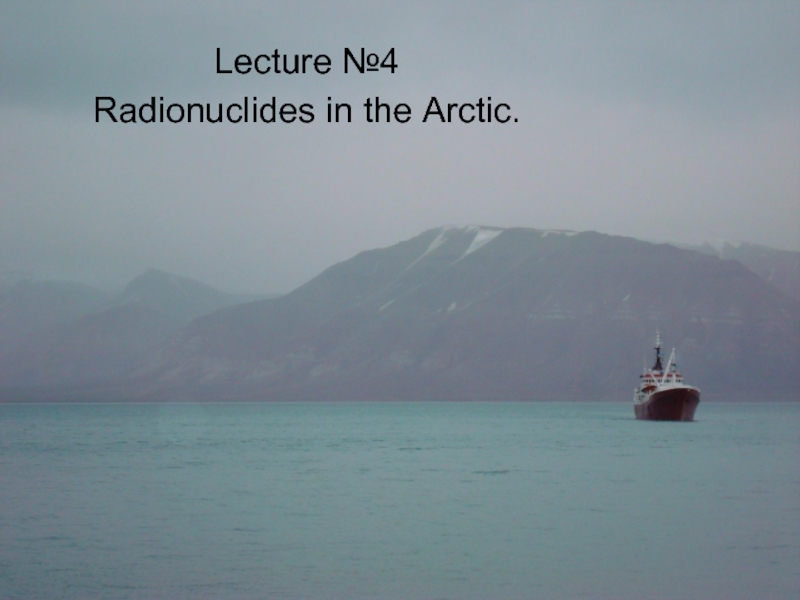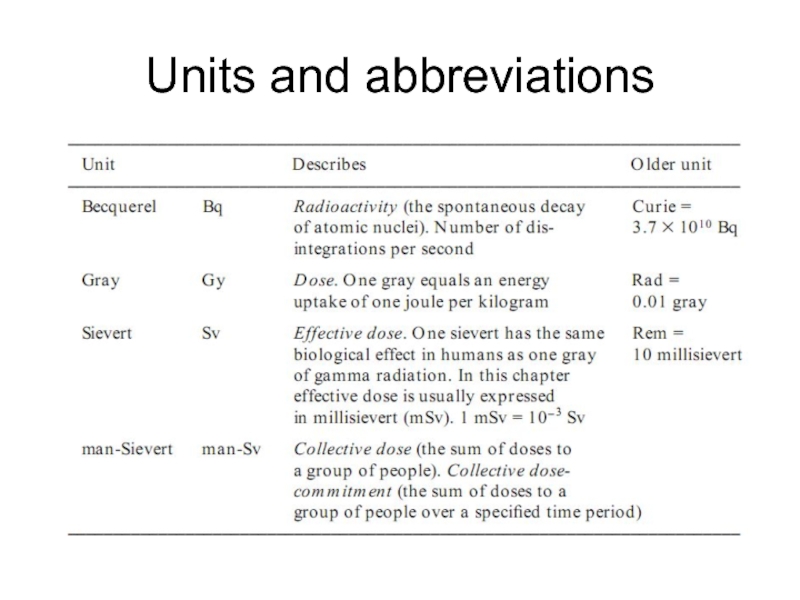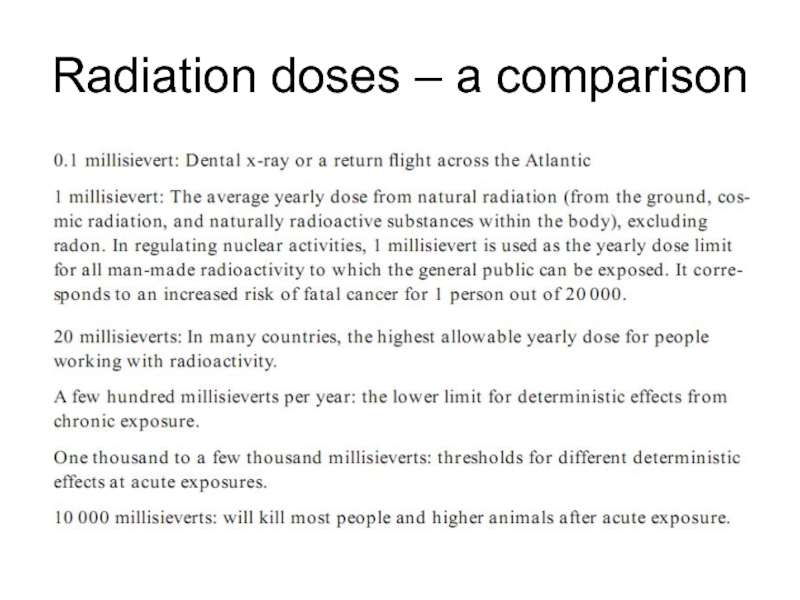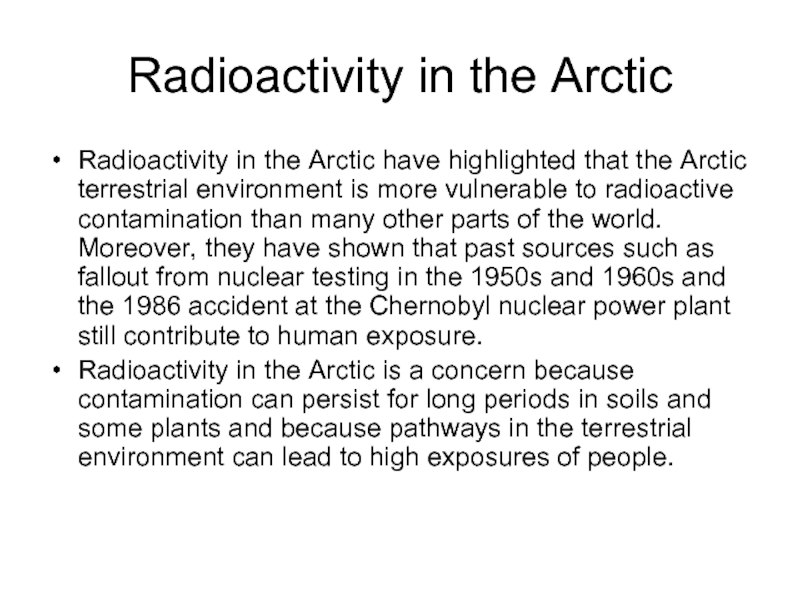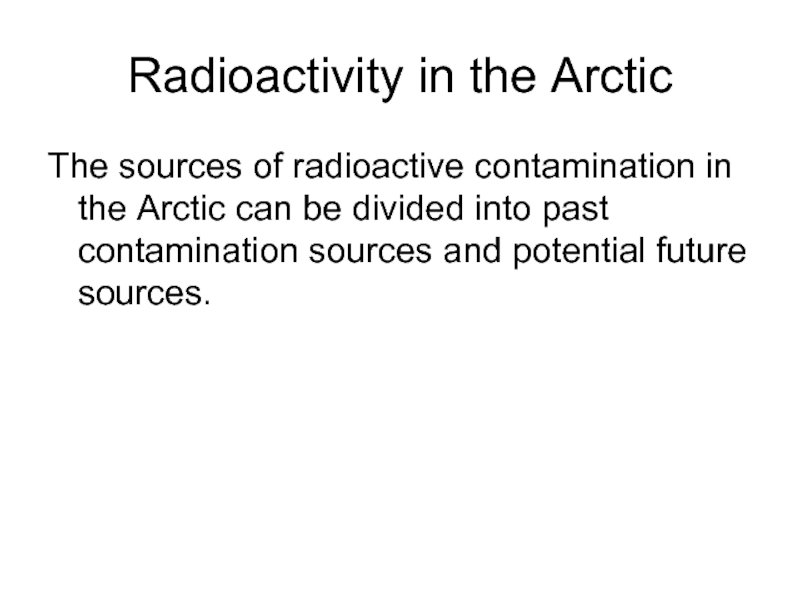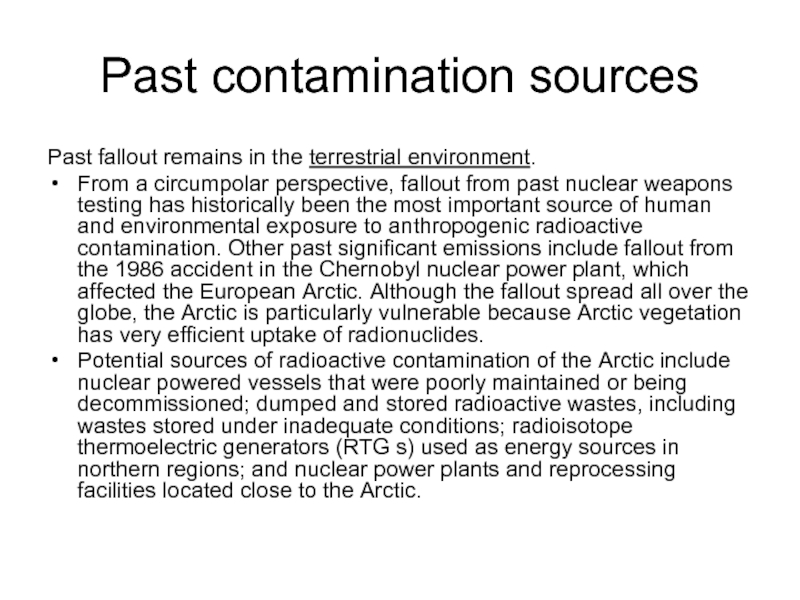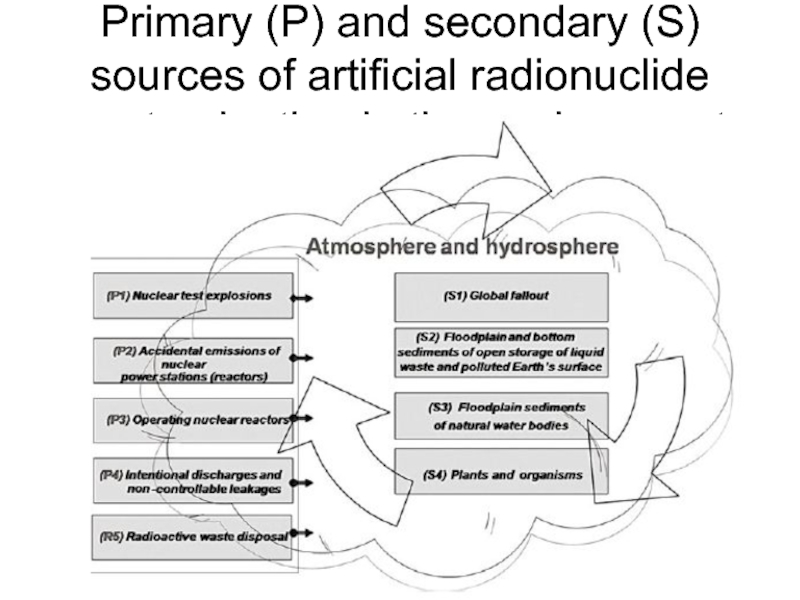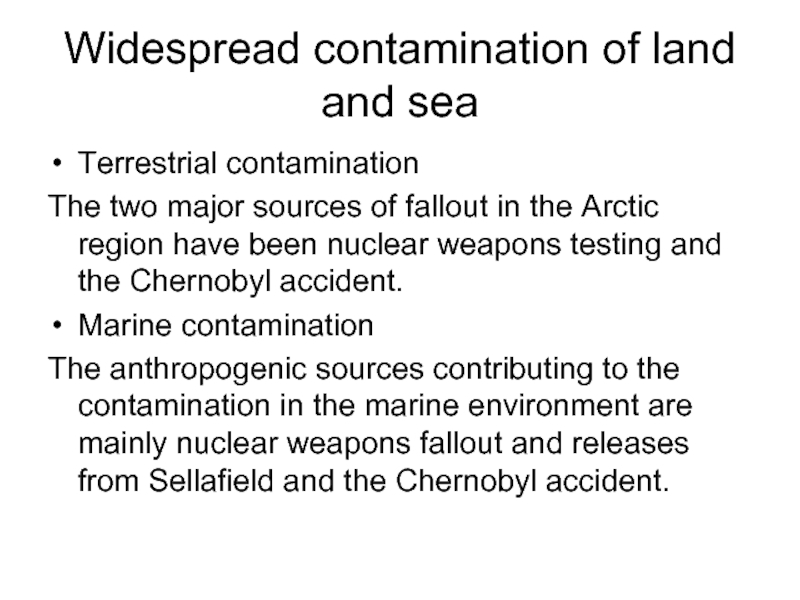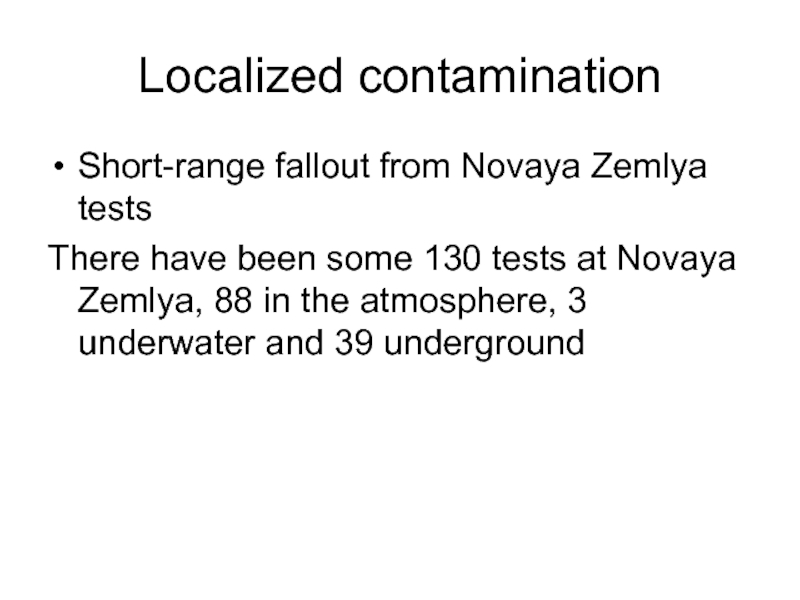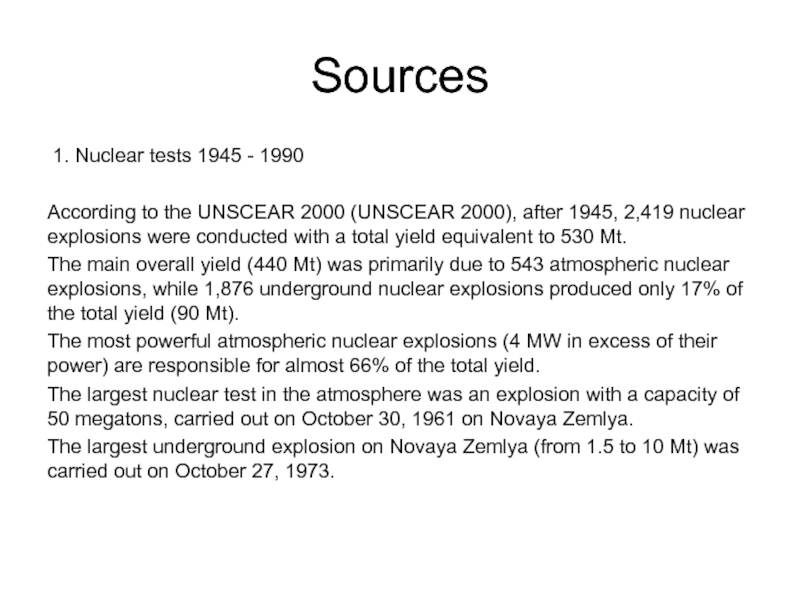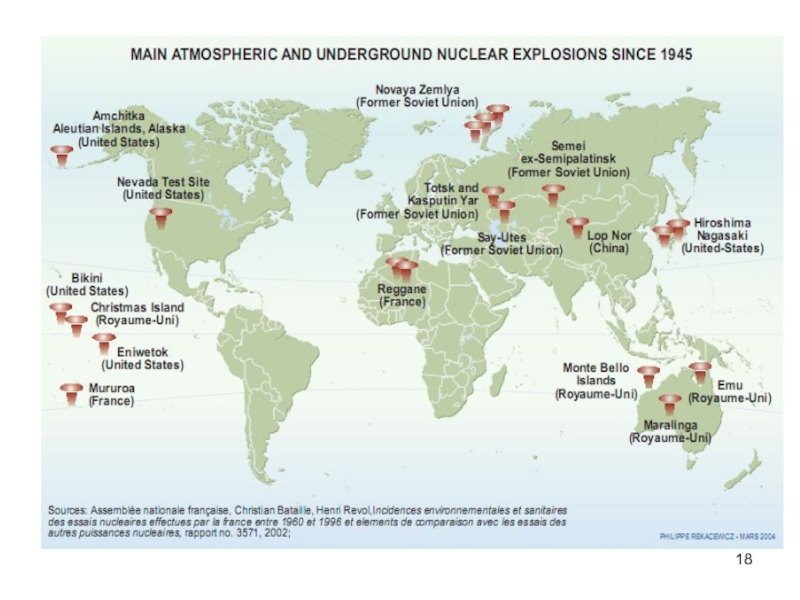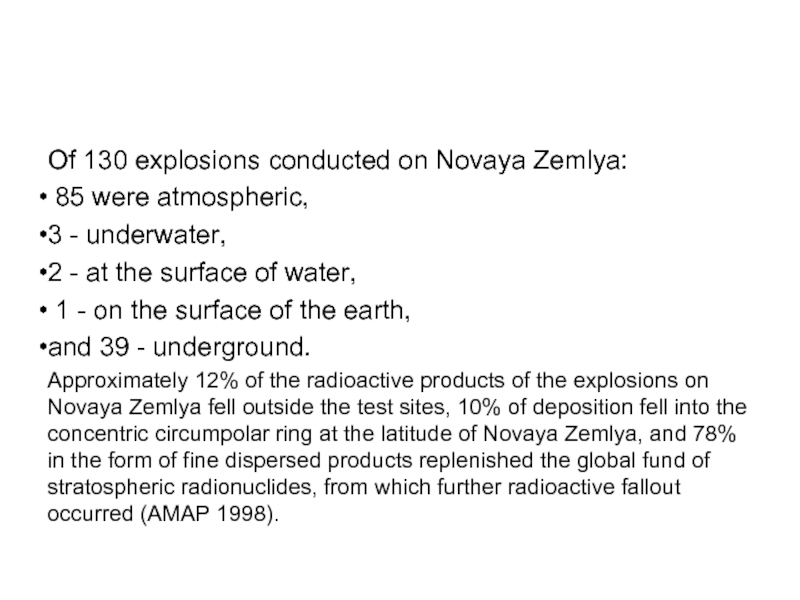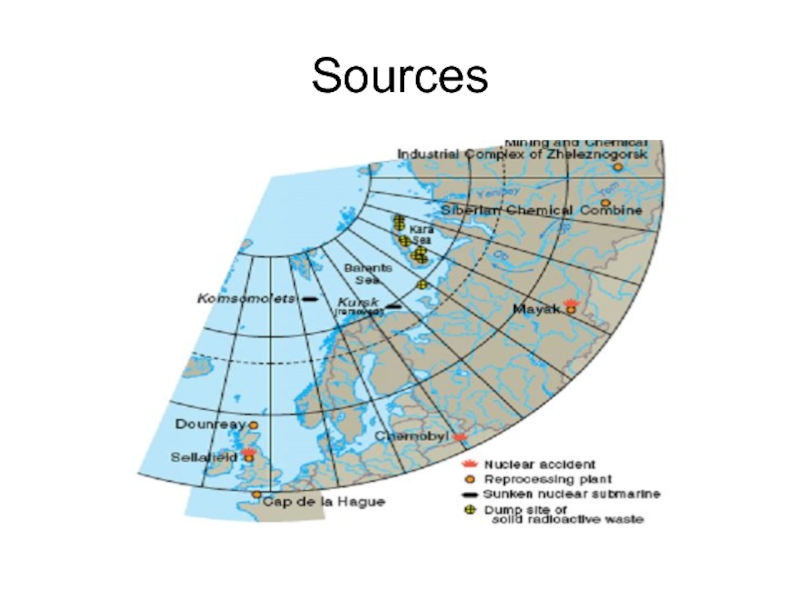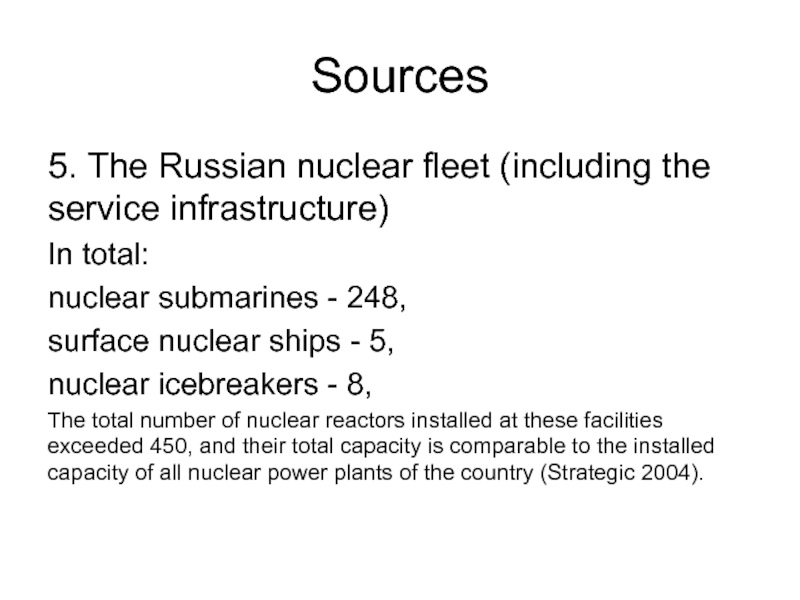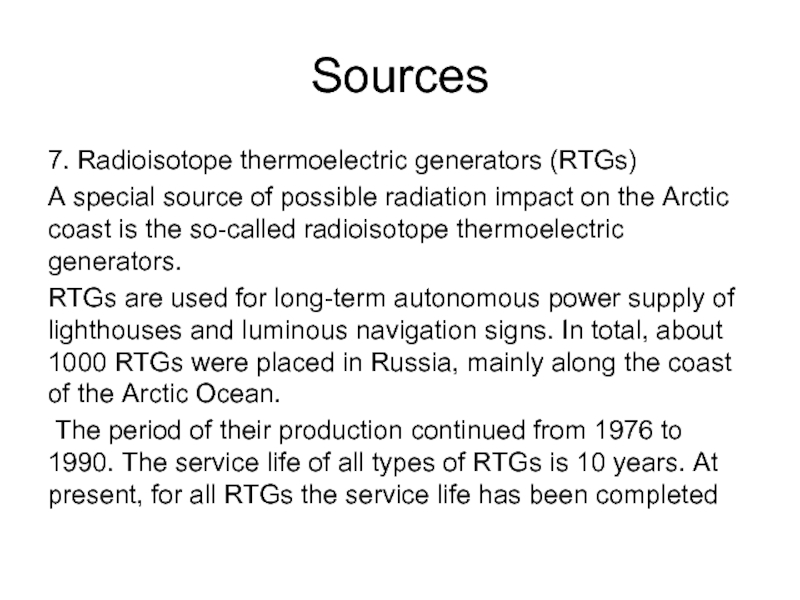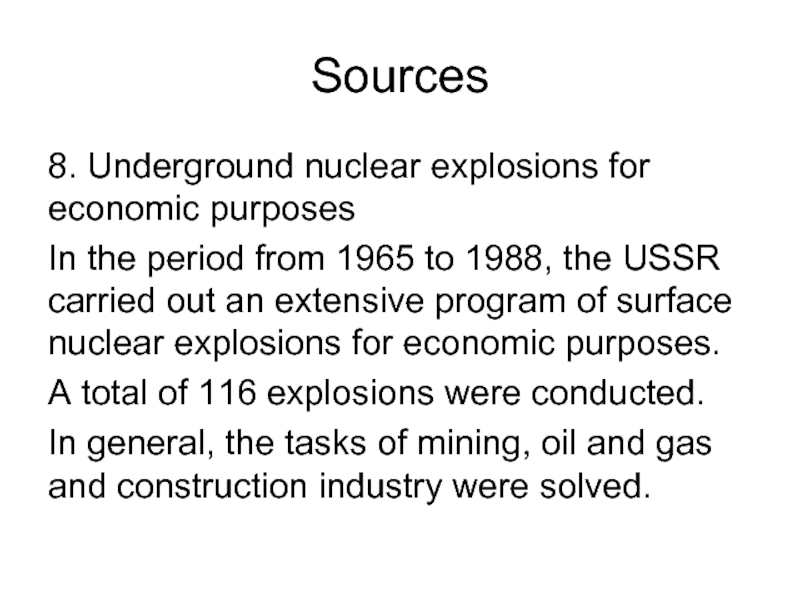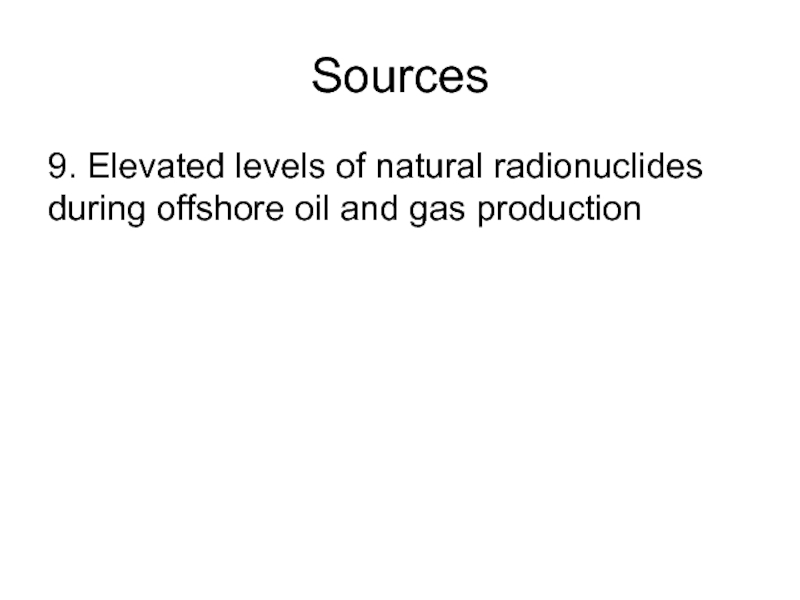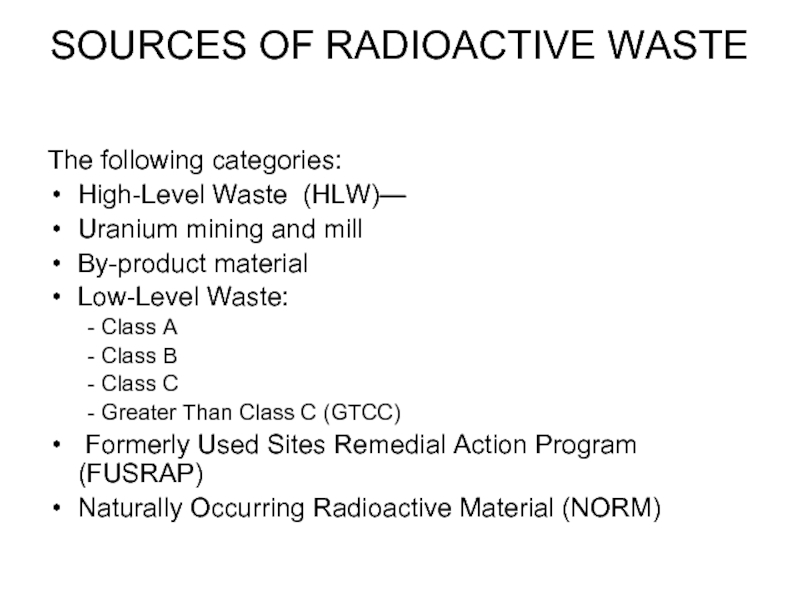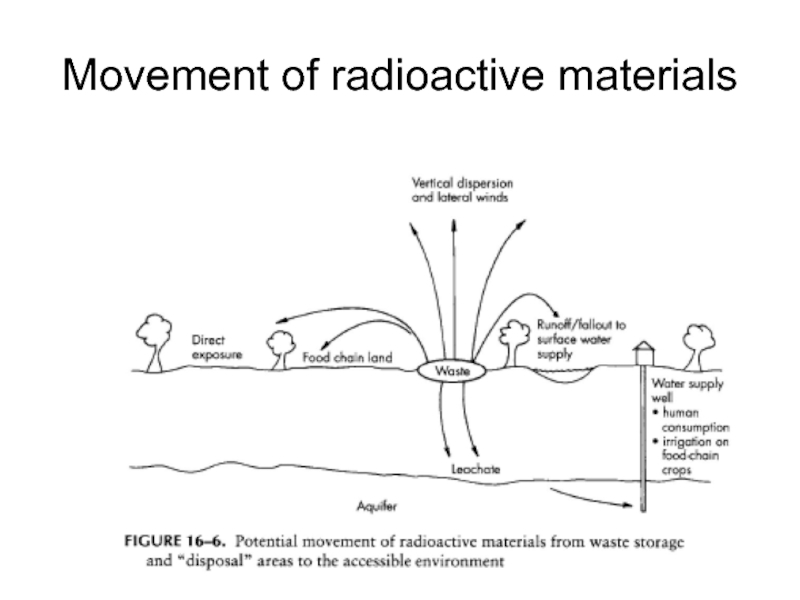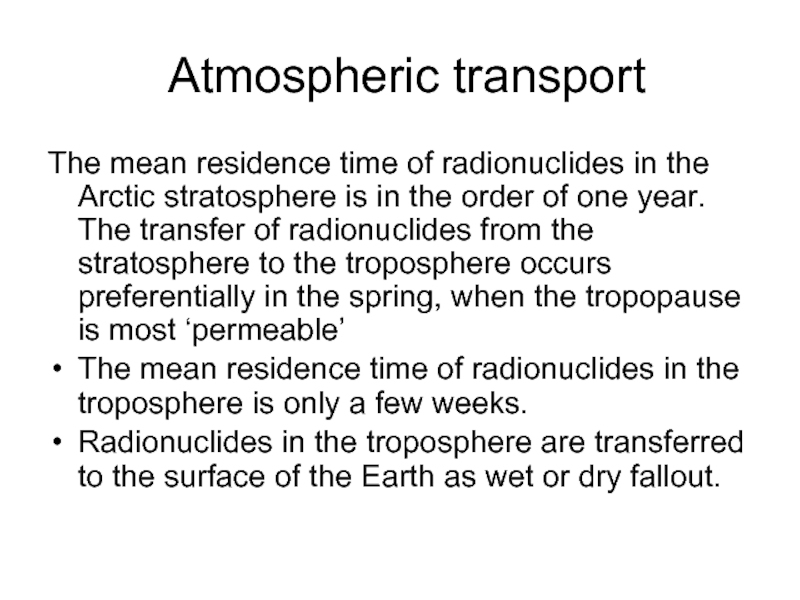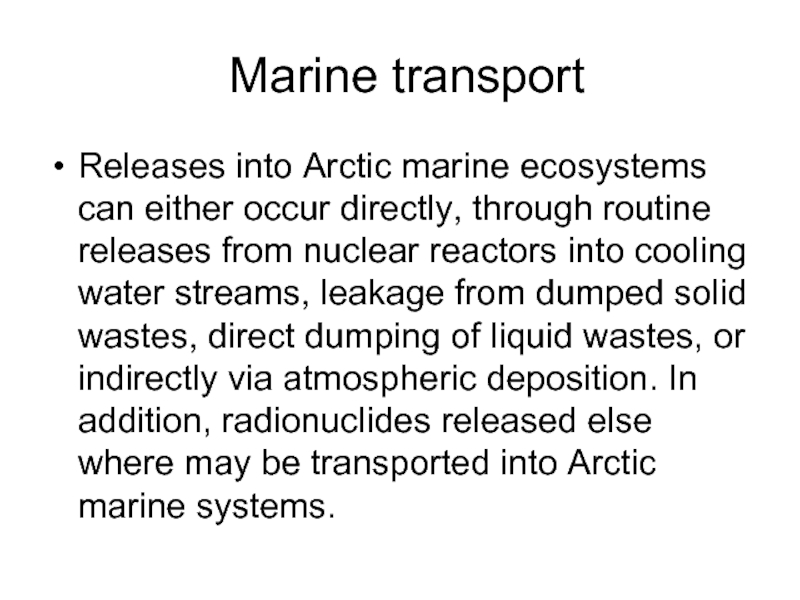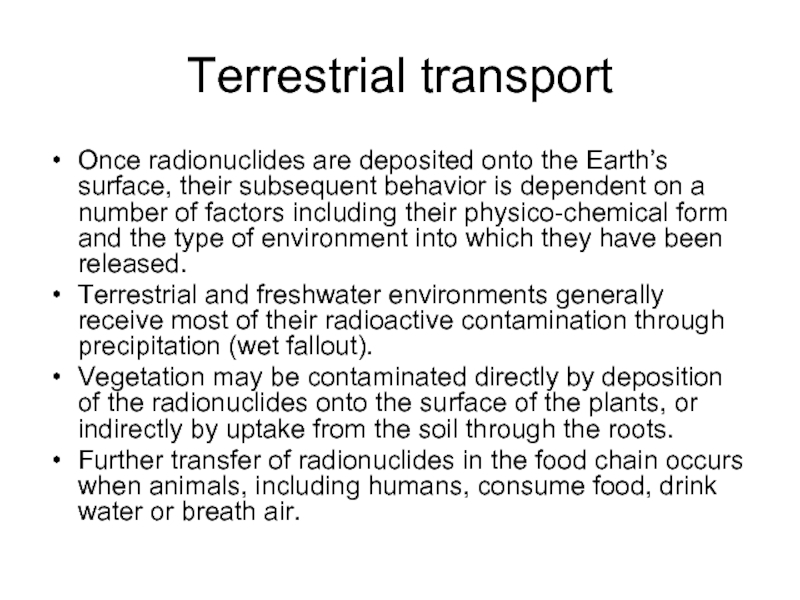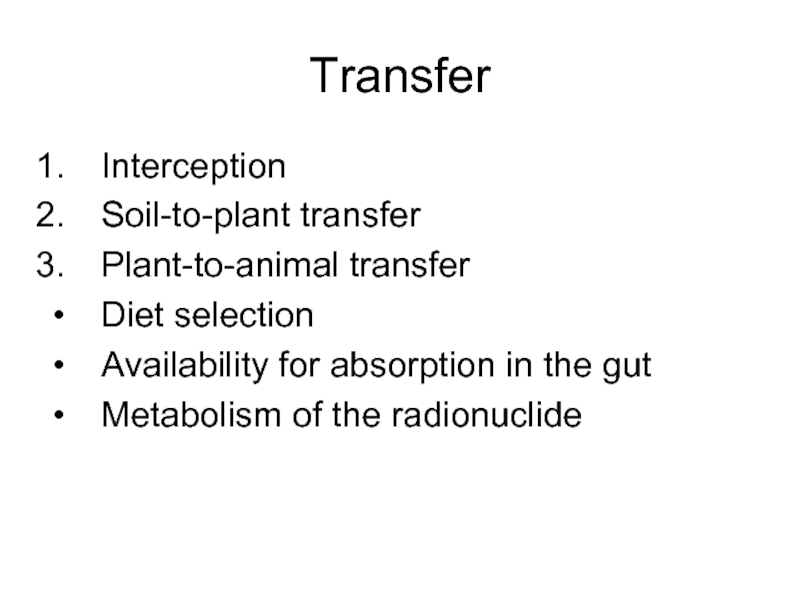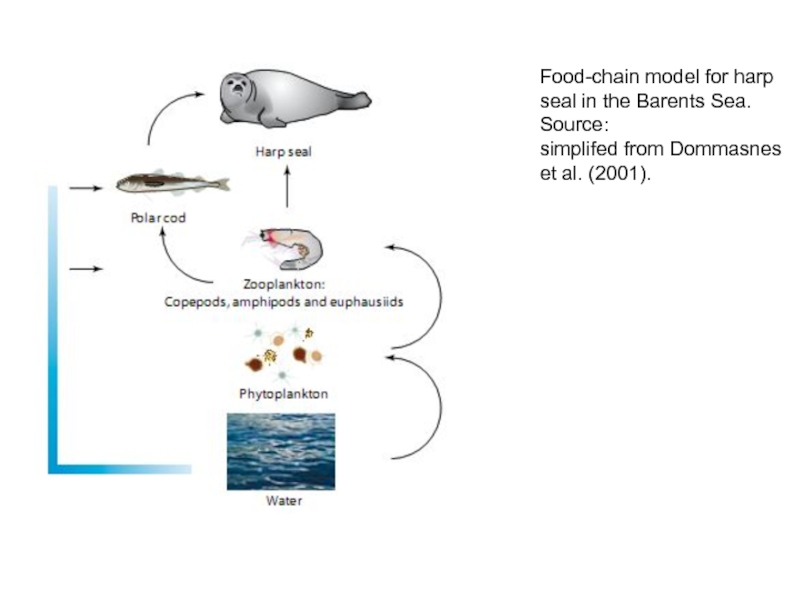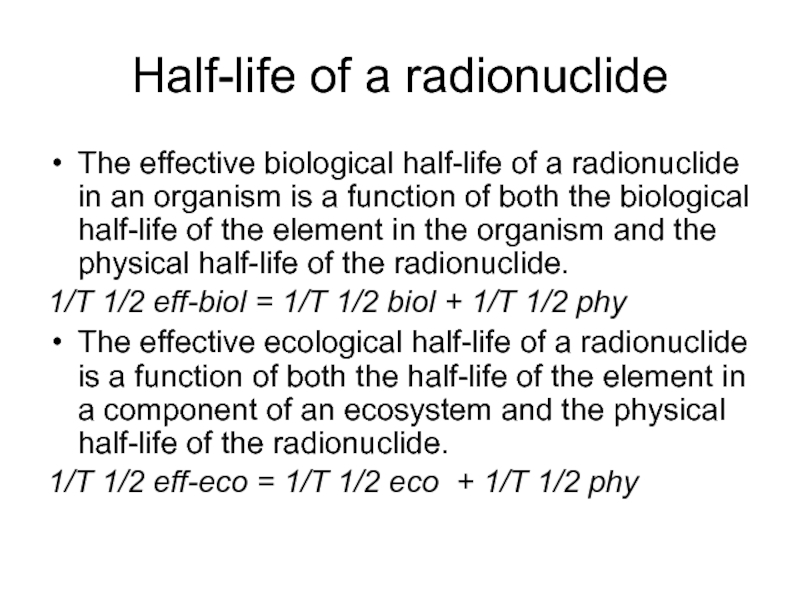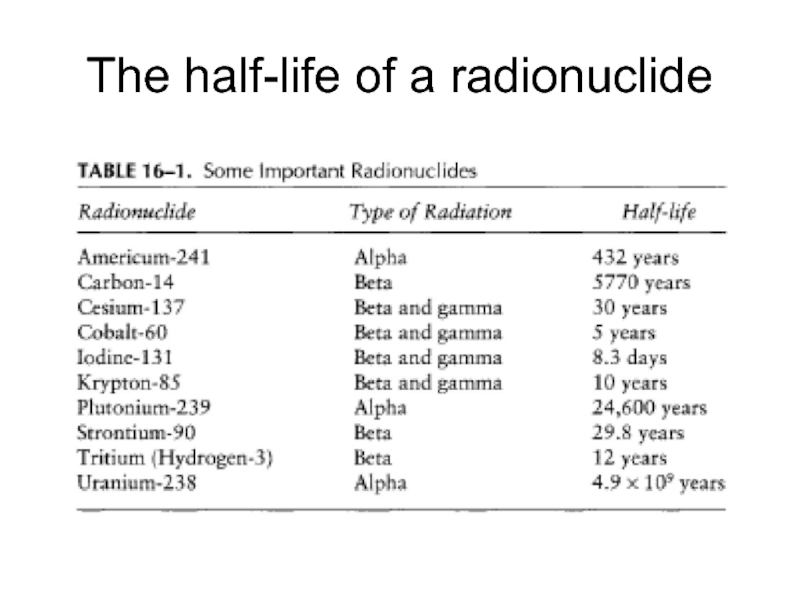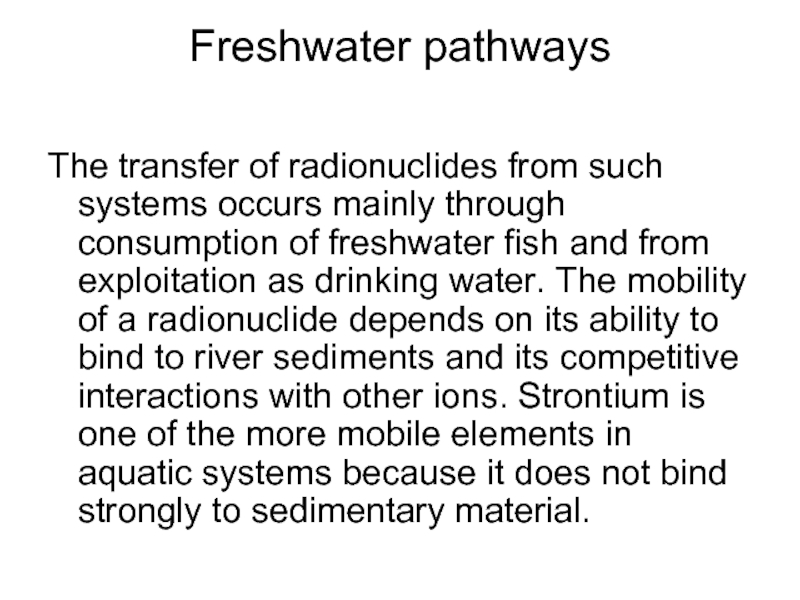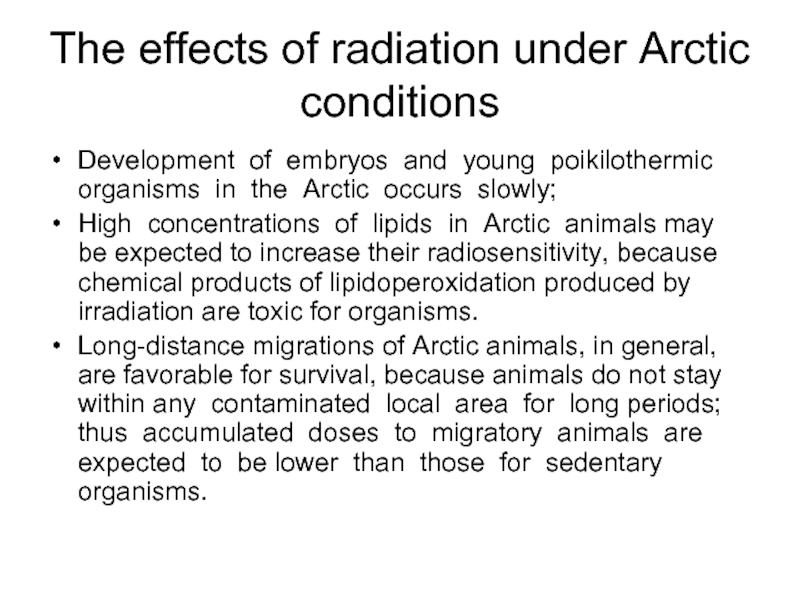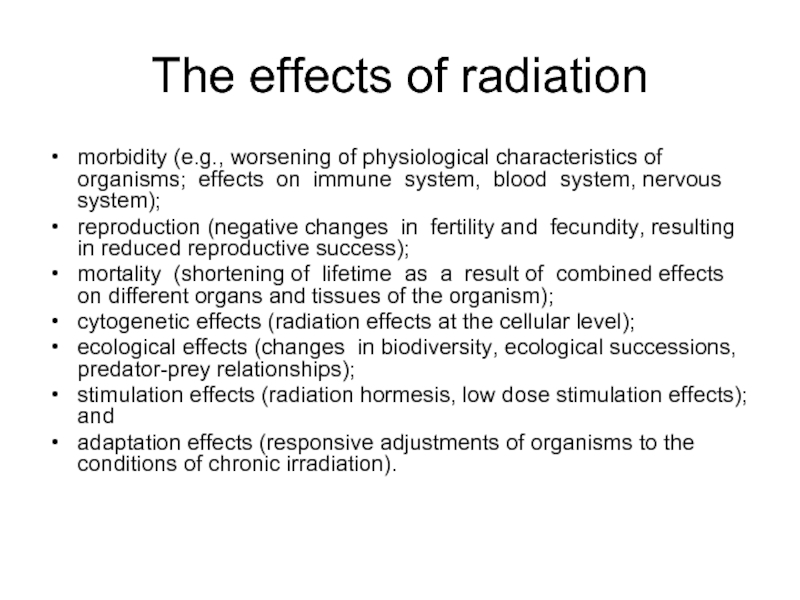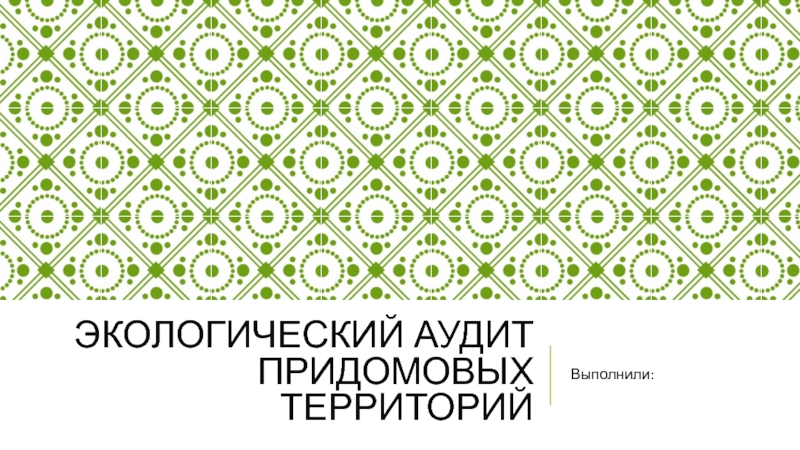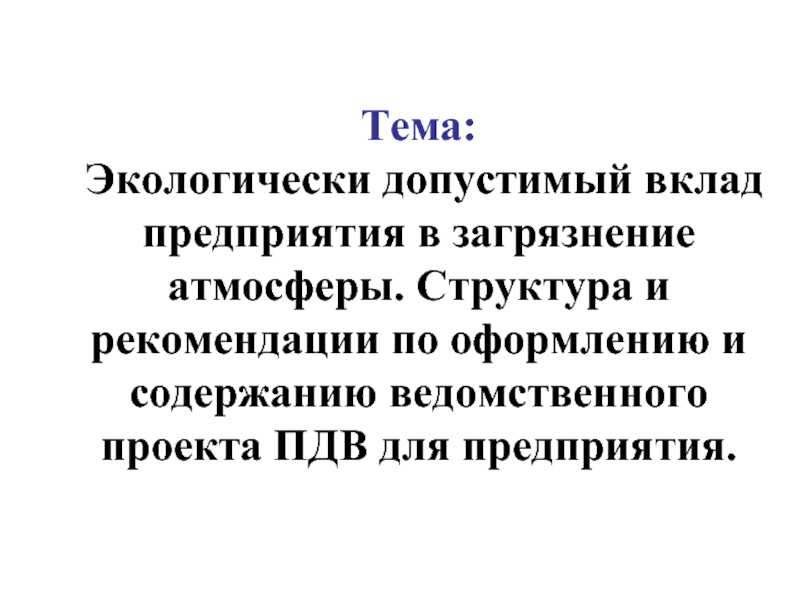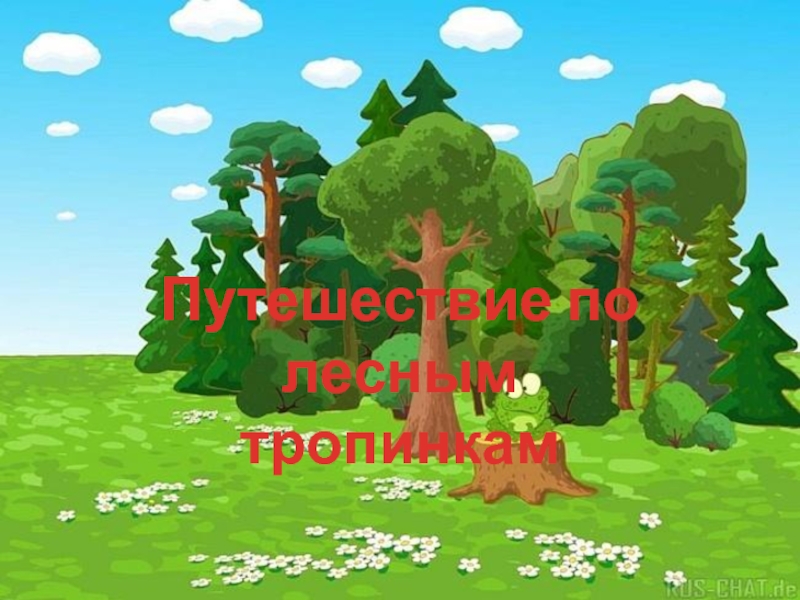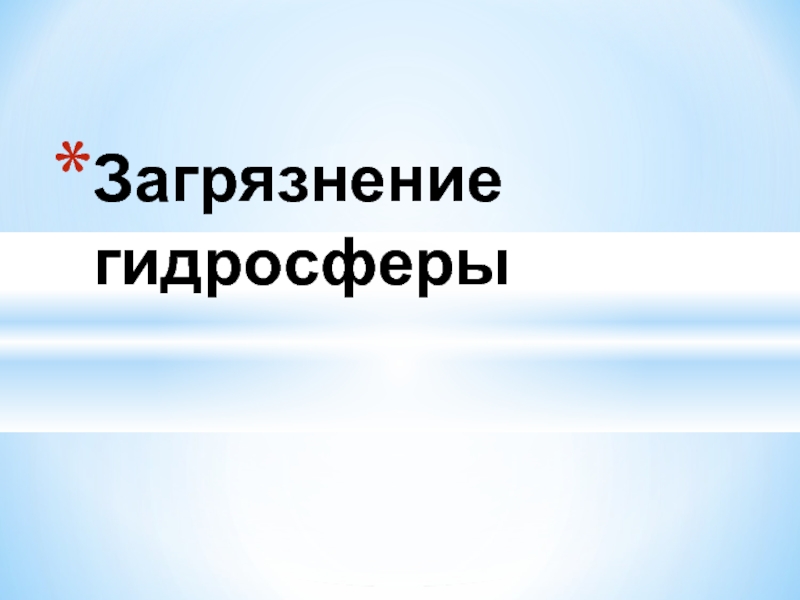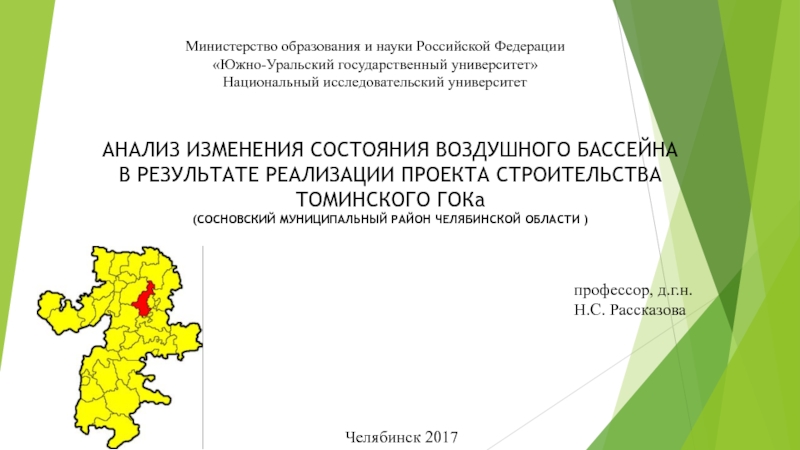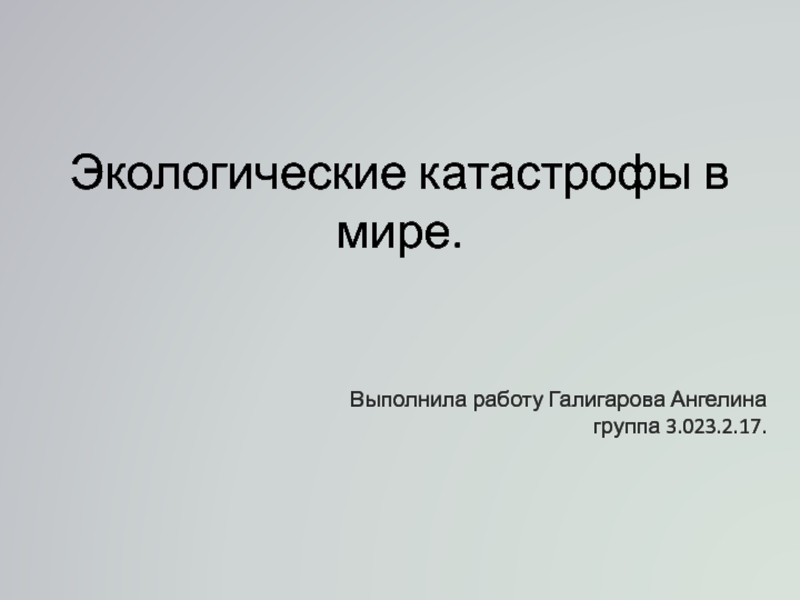- Главная
- Разное
- Дизайн
- Бизнес и предпринимательство
- Аналитика
- Образование
- Развлечения
- Красота и здоровье
- Финансы
- Государство
- Путешествия
- Спорт
- Недвижимость
- Армия
- Графика
- Культурология
- Еда и кулинария
- Лингвистика
- Английский язык
- Астрономия
- Алгебра
- Биология
- География
- Детские презентации
- Информатика
- История
- Литература
- Маркетинг
- Математика
- Медицина
- Менеджмент
- Музыка
- МХК
- Немецкий язык
- ОБЖ
- Обществознание
- Окружающий мир
- Педагогика
- Русский язык
- Технология
- Физика
- Философия
- Химия
- Шаблоны, картинки для презентаций
- Экология
- Экономика
- Юриспруденция
Radionuclides in the Arctic презентация
Содержание
- 1. Radionuclides in the Arctic
- 2. Radioactivity Radioactivity is the property of spontaneous
- 3. Radioactivity The SI (Standards Internationaux) unit of
- 4. Units and abbreviations
- 5. Radiation doses – a comparison
- 6. Natural radioactivity Natural radioactivity is derived from
- 7. Artificial radioactivity. In most situations, the most
- 9. Radioactivity in the Arctic Radioactivity in the
- 10. Radioactivity in the Arctic The sources of
- 11. Past contamination sources Past fallout remains in
- 12. Primary (P) and secondary (S) sources of artificial radionuclide contamination in the environment
- 13. Radioactivity in the Arctic Radioactive contamination of
- 14. NUCLEAR ACTIVITIES IN THE ARCTIC OVER THE LAST 50 YEARS
- 15. Widespread contamination of land and sea
- 16. Localized contamination Short-range fallout from Novaya Zemlya
- 17. Sources 1. Nuclear tests 1945 -
- 19. Of 130 explosions conducted on Novaya
- 20. 137 CESIUM FROM NUCLEAR WEAPON’S TESTING FALLOUT
- 21. Sources 2. The Chernobyl accident of 1986
- 22. Sources 3. Western European radiochemical plants for
- 23. Sources
- 24. Sources 4. Radiochemical plants of Russia Currently,
- 25. Sources 5. The Russian nuclear fleet (including
- 26. Sources 6. Kola and Bilibino nuclear power plants,
- 27. Sources 7. Radioisotope thermoelectric generators (RTGs) A
- 28. Sources 8. Underground nuclear explosions for economic
- 29. Sources 9. Elevated levels of natural radionuclides during offshore oil and gas production
- 31. SOURCES OF RADIOACTIVE WASTE The following
- 32. Movement of radioactive materials
- 33. Atmospheric transport The mean residence time
- 34. Marine transport Releases into Arctic marine
- 35. Terrestrial transport Once radionuclides are deposited onto
- 36. Transfer Interception Soil-to-plant transfer Plant-to-animal
- 37. Food-chain model for harp seal in the
- 38. Half-life of a radionuclide The effective biological
- 39. The half-life of a radionuclide
- 40. Freshwater pathways The transfer of
- 41. Marine pathways Exposure from marine pathways
- 42. The effects of radiation under Arctic
- 43. The effects of radiation under Arctic
- 44. The effects of radiation morbidity (e.g., worsening
Слайд 2Radioactivity
Radioactivity is the property of spontaneous disintegration, or decay, of atomic
nuclei accompanied by the emission of ionizing radiation. Activity corresponds to the number of disintegrations per second of an isotope (with dimensions T –1).
Слайд 3Radioactivity
The SI (Standards Internationaux) unit of activity is the reciprocal second
(s –1 ) with the name Becquerel (Bq). The older, non-SI, unit Curie (Ci) that was derived from the (presumed) activity of one gram of radium and is still used in some fora, corresponds to 3.7*10 10 Bq.
Слайд 6Natural radioactivity
Natural radioactivity is derived from the decay of nuclei in
the Earth’s crust and by the bombardment of the Earth by cosmic radiation producing radionuclides in the Earth’s atmosphere.
These natural radionuclides fall into three categories:
the very long-lived primordial radionuclides (40 K, 238 U, 232 Th, 235 U) formed at the time the Earth was created;
decay chain radionuclides (radionuclides in the uranium, thorium and actinium decay series) that are the products of decay of primordial nuclides;
and cosmogenic nuclides produced by the interaction of high energy cosmic radiation with the Earth’s atmosphere (e.g., 3 H, 7 Be, 14 C, 22 Na).
These natural radionuclides fall into three categories:
the very long-lived primordial radionuclides (40 K, 238 U, 232 Th, 235 U) formed at the time the Earth was created;
decay chain radionuclides (radionuclides in the uranium, thorium and actinium decay series) that are the products of decay of primordial nuclides;
and cosmogenic nuclides produced by the interaction of high energy cosmic radiation with the Earth’s atmosphere (e.g., 3 H, 7 Be, 14 C, 22 Na).
Слайд 7Artificial radioactivity.
In most situations, the most radiologically important fission products in
the short term are 89 Sr, 90 Sr, 131 I and 137 Cs, and in the long term, 90 Sr and 137 Cs, because of their yields, half-lives and chemical properties. Activation products are the isotopes formed principally by the capture of neutrons by stable isotopes in high neutron flux environments.
Слайд 9Radioactivity in the Arctic
Radioactivity in the Arctic have highlighted that the
Arctic terrestrial environment is more vulnerable to radioactive contamination than many other parts of the world. Moreover, they have shown that past sources such as fallout from nuclear testing in the 1950s and 1960s and the 1986 accident at the Chernobyl nuclear power plant still contribute to human exposure.
Radioactivity in the Arctic is a concern because contamination can persist for long periods in soils and some plants and because pathways in the terrestrial environment can lead to high exposures of people.
Radioactivity in the Arctic is a concern because contamination can persist for long periods in soils and some plants and because pathways in the terrestrial environment can lead to high exposures of people.
Слайд 10Radioactivity in the Arctic
The sources of radioactive contamination in the Arctic
can be divided into past contamination sources and potential future sources.
Слайд 11Past contamination sources
Past fallout remains in the terrestrial environment.
From a
circumpolar perspective, fallout from past nuclear weapons testing has historically been the most important source of human and environmental exposure to anthropogenic radioactive contamination. Other past significant emissions include fallout from the 1986 accident in the Chernobyl nuclear power plant, which affected the European Arctic. Although the fallout spread all over the globe, the Arctic is particularly vulnerable because Arctic vegetation has very efficient uptake of radionuclides.
Potential sources of radioactive contamination of the Arctic include nuclear powered vessels that were poorly maintained or being decommissioned; dumped and stored radioactive wastes, including wastes stored under inadequate conditions; radioisotope thermoelectric generators (RTG s) used as energy sources in northern regions; and nuclear power plants and reprocessing facilities located close to the Arctic.
Potential sources of radioactive contamination of the Arctic include nuclear powered vessels that were poorly maintained or being decommissioned; dumped and stored radioactive wastes, including wastes stored under inadequate conditions; radioisotope thermoelectric generators (RTG s) used as energy sources in northern regions; and nuclear power plants and reprocessing facilities located close to the Arctic.
Слайд 12Primary (P) and secondary (S) sources of artificial radionuclide contamination in
the environment
Слайд 13Radioactivity in the Arctic
Radioactive contamination of the Arctic has occurred at
two different scales:
1. Widespread contamination, such as that associated with global nuclear weapons testing, Sellafield releases and the Chernobyl accident.
2. Localized contamination of smaller areas (e.g., resulting from the Thule nuclear weapons accident and radioactive wastes dumped at sea). The following presentation focuses on 137 Cs and 90 Sr, since these radionuclides are important for determining dose to humans, and considerable data exist on each of them.
1. Widespread contamination, such as that associated with global nuclear weapons testing, Sellafield releases and the Chernobyl accident.
2. Localized contamination of smaller areas (e.g., resulting from the Thule nuclear weapons accident and radioactive wastes dumped at sea). The following presentation focuses on 137 Cs and 90 Sr, since these radionuclides are important for determining dose to humans, and considerable data exist on each of them.
Слайд 15Widespread contamination of land and sea
Terrestrial contamination
The two major sources
of fallout in the Arctic region have been nuclear weapons testing and the Chernobyl accident.
Marine contamination
The anthropogenic sources contributing to the contamination in the marine environment are mainly nuclear weapons fallout and releases from Sellafield and the Chernobyl accident.
Marine contamination
The anthropogenic sources contributing to the contamination in the marine environment are mainly nuclear weapons fallout and releases from Sellafield and the Chernobyl accident.
Слайд 16Localized contamination
Short-range fallout from Novaya Zemlya tests
There have been some 130
tests at Novaya Zemlya, 88 in the atmosphere, 3 underwater and 39 underground
Слайд 17Sources
1. Nuclear tests 1945 - 1990
According to the UNSCEAR
2000 (UNSCEAR 2000), after 1945, 2,419 nuclear explosions were conducted with a total yield equivalent to 530 Mt.
The main overall yield (440 Mt) was primarily due to 543 atmospheric nuclear explosions, while 1,876 underground nuclear explosions produced only 17% of the total yield (90 Mt).
The most powerful atmospheric nuclear explosions (4 MW in excess of their power) are responsible for almost 66% of the total yield.
The largest nuclear test in the atmosphere was an explosion with a capacity of 50 megatons, carried out on October 30, 1961 on Novaya Zemlya.
The largest underground explosion on Novaya Zemlya (from 1.5 to 10 Mt) was carried out on October 27, 1973.
The main overall yield (440 Mt) was primarily due to 543 atmospheric nuclear explosions, while 1,876 underground nuclear explosions produced only 17% of the total yield (90 Mt).
The most powerful atmospheric nuclear explosions (4 MW in excess of their power) are responsible for almost 66% of the total yield.
The largest nuclear test in the atmosphere was an explosion with a capacity of 50 megatons, carried out on October 30, 1961 on Novaya Zemlya.
The largest underground explosion on Novaya Zemlya (from 1.5 to 10 Mt) was carried out on October 27, 1973.
Слайд 19
Of 130 explosions conducted on Novaya Zemlya:
85 were atmospheric,
3
- underwater,
2 - at the surface of water,
1 - on the surface of the earth,
and 39 - underground.
Approximately 12% of the radioactive products of the explosions on Novaya Zemlya fell outside the test sites, 10% of deposition fell into the concentric circumpolar ring at the latitude of Novaya Zemlya, and 78% in the form of fine dispersed products replenished the global fund of stratospheric radionuclides, from which further radioactive fallout occurred (AMAP 1998).
2 - at the surface of water,
1 - on the surface of the earth,
and 39 - underground.
Approximately 12% of the radioactive products of the explosions on Novaya Zemlya fell outside the test sites, 10% of deposition fell into the concentric circumpolar ring at the latitude of Novaya Zemlya, and 78% in the form of fine dispersed products replenished the global fund of stratospheric radionuclides, from which further radioactive fallout occurred (AMAP 1998).
Слайд 22Sources
3. Western European radiochemical plants for processing nuclear fuel.
At radio chemical
plants, uranium and plutonium are separated from spent nuclear fuel for reuse, which is accompanied by the formation of a large number of various radioactive waste (UNSCEAR 2000).
The most powerful and currently operating plants in Western Europe are Sellafield (Great Britain) and La Ag (France).
Discharges Sellafield through the pipes fall into the Irish Sea, and discharges RHZ on Cape La Ag in the Channel English Channel.
The most powerful and currently operating plants in Western Europe are Sellafield (Great Britain) and La Ag (France).
Discharges Sellafield through the pipes fall into the Irish Sea, and discharges RHZ on Cape La Ag in the Channel English Channel.
Слайд 24Sources
4. Radiochemical plants of Russia
Currently, there are five Rosatom nuclear fuel
cycle plants that can influence the water environment of the Arctic seas.
The main ones are Mayak complex in Chelyabinsk Oblast (Ob River basin), Siberian Chemical Plant Tomsk-7 in Tomsk Oblast (Ob River Basin), Krasnoyarsk Mining and Chemical Combine in the Krasnoyarsk Territory (Yenisei Basin) (AMAP 1998).
The main ones are Mayak complex in Chelyabinsk Oblast (Ob River basin), Siberian Chemical Plant Tomsk-7 in Tomsk Oblast (Ob River Basin), Krasnoyarsk Mining and Chemical Combine in the Krasnoyarsk Territory (Yenisei Basin) (AMAP 1998).
Слайд 25Sources
5. The Russian nuclear fleet (including the service infrastructure)
In total:
nuclear submarines
- 248,
surface nuclear ships - 5,
nuclear icebreakers - 8,
The total number of nuclear reactors installed at these facilities exceeded 450, and their total capacity is comparable to the installed capacity of all nuclear power plants of the country (Strategic 2004).
surface nuclear ships - 5,
nuclear icebreakers - 8,
The total number of nuclear reactors installed at these facilities exceeded 450, and their total capacity is comparable to the installed capacity of all nuclear power plants of the country (Strategic 2004).
Слайд 27Sources
7. Radioisotope thermoelectric generators (RTGs)
A special source of possible radiation impact
on the Arctic coast is the so-called radioisotope thermoelectric generators.
RTGs are used for long-term autonomous power supply of lighthouses and luminous navigation signs. In total, about 1000 RTGs were placed in Russia, mainly along the coast of the Arctic Ocean.
The period of their production continued from 1976 to 1990. The service life of all types of RTGs is 10 years. At present, for all RTGs the service life has been completed
RTGs are used for long-term autonomous power supply of lighthouses and luminous navigation signs. In total, about 1000 RTGs were placed in Russia, mainly along the coast of the Arctic Ocean.
The period of their production continued from 1976 to 1990. The service life of all types of RTGs is 10 years. At present, for all RTGs the service life has been completed
Слайд 28Sources
8. Underground nuclear explosions for economic purposes
In the period from 1965
to 1988, the USSR carried out an extensive program of surface nuclear explosions for economic purposes.
A total of 116 explosions were conducted.
In general, the tasks of mining, oil and gas and construction industry were solved.
A total of 116 explosions were conducted.
In general, the tasks of mining, oil and gas and construction industry were solved.
Слайд 31SOURCES OF RADIOACTIVE WASTE
The following categories:
High-Level Waste (HLW)—
Uranium mining and mill
By-product
material
Low-Level Waste:
- Class A
- Class B
- Class C
- Greater Than Class C (GTCC)
Formerly Used Sites Remedial Action Program (FUSRAP)
Naturally Occurring Radioactive Material (NORM)
Low-Level Waste:
- Class A
- Class B
- Class C
- Greater Than Class C (GTCC)
Formerly Used Sites Remedial Action Program (FUSRAP)
Naturally Occurring Radioactive Material (NORM)
Слайд 33 Atmospheric transport
The mean residence time of radionuclides in the Arctic
stratosphere is in the order of one year. The transfer of radionuclides from the stratosphere to the troposphere occurs preferentially in the spring, when the tropopause is most ‘permeable’
The mean residence time of radionuclides in the troposphere is only a few weeks.
Radionuclides in the troposphere are transferred to the surface of the Earth as wet or dry fallout.
The mean residence time of radionuclides in the troposphere is only a few weeks.
Radionuclides in the troposphere are transferred to the surface of the Earth as wet or dry fallout.
Слайд 34 Marine transport
Releases into Arctic marine ecosystems can either occur directly,
through routine releases from nuclear reactors into cooling water streams, leakage from dumped solid wastes, direct dumping of liquid wastes, or indirectly via atmospheric deposition. In addition, radionuclides released else where may be transported into Arctic marine systems.
Слайд 35Terrestrial transport
Once radionuclides are deposited onto the Earth’s surface, their subsequent
behavior is dependent on a number of factors including their physico-chemical form and the type of environment into which they have been released.
Terrestrial and freshwater environments generally receive most of their radioactive contamination through precipitation (wet fallout).
Vegetation may be contaminated directly by deposition of the radionuclides onto the surface of the plants, or indirectly by uptake from the soil through the roots.
Further transfer of radionuclides in the food chain occurs when animals, including humans, consume food, drink water or breath air.
Terrestrial and freshwater environments generally receive most of their radioactive contamination through precipitation (wet fallout).
Vegetation may be contaminated directly by deposition of the radionuclides onto the surface of the plants, or indirectly by uptake from the soil through the roots.
Further transfer of radionuclides in the food chain occurs when animals, including humans, consume food, drink water or breath air.
Слайд 36Transfer
Interception
Soil-to-plant transfer
Plant-to-animal transfer
Diet selection
Availability for absorption in
the gut
Metabolism of the radionuclide
Metabolism of the radionuclide
Слайд 37Food-chain model for harp seal in the Barents Sea. Source:
simplifed
from Dommasnes et al. (2001).
Слайд 38Half-life of a radionuclide
The effective biological half-life of a radionuclide in
an organism is a function of both the biological half-life of the element in the organism and the physical half-life of the radionuclide.
1/T 1/2 eff-biol = 1/T 1/2 biol + 1/T 1/2 phy
The effective ecological half-life of a radionuclide is a function of both the half-life of the element in a component of an ecosystem and the physical half-life of the radionuclide.
1/T 1/2 eff-eco = 1/T 1/2 eco + 1/T 1/2 phy
1/T 1/2 eff-biol = 1/T 1/2 biol + 1/T 1/2 phy
The effective ecological half-life of a radionuclide is a function of both the half-life of the element in a component of an ecosystem and the physical half-life of the radionuclide.
1/T 1/2 eff-eco = 1/T 1/2 eco + 1/T 1/2 phy
Слайд 40Freshwater pathways
The transfer of radionuclides from such systems occurs mainly
through consumption of freshwater fish and from exploitation as drinking water. The mobility of a radionuclide depends on its ability to bind to river sediments and its competitive interactions with other ions. Strontium is one of the more mobile elements in aquatic systems because it does not bind strongly to sedimentary material.
Слайд 41Marine pathways
Exposure from marine pathways arises from the consumption of
marine food products, including fish and shellfish, mammals such as seals and whales, and seaweed. In general, contamination of marine biota is much less than that arising from terrestrial pathways, largely because of the strong sorption of many radionuclides by aquatic sediments and also because of the enormous dilution which occurs in marine water bodies
Слайд 42The effects of radiation under Arctic
conditions:
Severe climatic conditions are
factors of natural environmental stress, restricting the number of biological species which are able to survive in the Arctic. Low biodiversity is a negative ecological factor associated with the low capacity of Arctic ecosystems to adapt in the case of any environmental changes.
The development of radiation effects in the Arctic poikilothermic (or hibernating) organisms is expected to occur more slowly, because of low environmental temperatures. On the other hand, repair of radiation damage in cells and tissues is not effective at very low temperatures. Lesions in the cooled (poikilothermic or hibernating) organisms are latent. However, if organisms become warm, lesions are rapidly revealed. As a result, radiation effects may not appear during the winter period, but may manifest themselves intensively during the warm season.
The development of radiation effects in the Arctic poikilothermic (or hibernating) organisms is expected to occur more slowly, because of low environmental temperatures. On the other hand, repair of radiation damage in cells and tissues is not effective at very low temperatures. Lesions in the cooled (poikilothermic or hibernating) organisms are latent. However, if organisms become warm, lesions are rapidly revealed. As a result, radiation effects may not appear during the winter period, but may manifest themselves intensively during the warm season.
Слайд 43The effects of radiation under Arctic
conditions
Development of embryos and young
poikilothermic organisms in the Arctic occurs slowly;
High concentrations of lipids in Arctic animals may be expected to increase their radiosensitivity, because chemical products of lipidoperoxidation produced by irradiation are toxic for organisms.
Long-distance migrations of Arctic animals, in general, are favorable for survival, because animals do not stay within any contaminated local area for long periods; thus accumulated doses to migratory animals are expected to be lower than those for sedentary organisms.
High concentrations of lipids in Arctic animals may be expected to increase their radiosensitivity, because chemical products of lipidoperoxidation produced by irradiation are toxic for organisms.
Long-distance migrations of Arctic animals, in general, are favorable for survival, because animals do not stay within any contaminated local area for long periods; thus accumulated doses to migratory animals are expected to be lower than those for sedentary organisms.
Слайд 44The effects of radiation
morbidity (e.g., worsening of physiological characteristics of organisms;
effects on immune system, blood system, nervous system);
reproduction (negative changes in fertility and fecundity, resulting in reduced reproductive success);
mortality (shortening of lifetime as a result of combined effects on different organs and tissues of the organism);
cytogenetic effects (radiation effects at the cellular level);
ecological effects (changes in biodiversity, ecological successions, predator-prey relationships);
stimulation effects (radiation hormesis, low dose stimulation effects); and
adaptation effects (responsive adjustments of organisms to the conditions of chronic irradiation).
reproduction (negative changes in fertility and fecundity, resulting in reduced reproductive success);
mortality (shortening of lifetime as a result of combined effects on different organs and tissues of the organism);
cytogenetic effects (radiation effects at the cellular level);
ecological effects (changes in biodiversity, ecological successions, predator-prey relationships);
stimulation effects (radiation hormesis, low dose stimulation effects); and
adaptation effects (responsive adjustments of organisms to the conditions of chronic irradiation).
